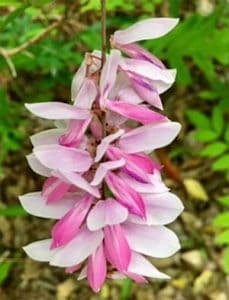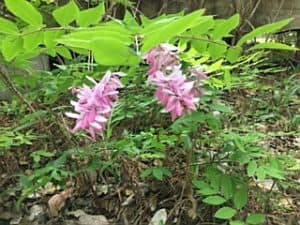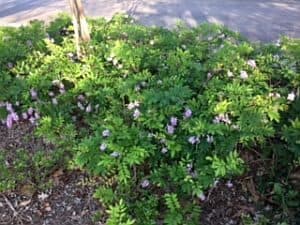
Indigo – Indigofera kirilowii
This perennial is a spreading low deciduous shrub of 2 ½ to 4 feet and is a native of China and Japan. This is a popular old plant of the South. This is not the Indigo that produces the dye, that is Indigofera tinctorial or tropical indigo.
The raceme flowers of Indigofera kirilowii grow up to 5 inches. They are pinkish-lavender in color and resemble wisteria as they hang beneath the foliage. The fernlike foliage is light green, pinnately compound alternate leaves with 7 to 11 leaflets on arching branches. Blooms Spring through Autumn. This member of the Fabaceae or Pea family produces pods of 1 ½ inches long.
Indigo makes an excellent ground cover as it has spreading form by underground suckers and clumps. It is a perfect plant to cover roots of trees or taller plants and looks good in containers. Indigo performs best in part shade areas. It grows fast and blooms on new wood. It may die back in freezes but recovers by root suckers and flowering is not affected. Soil should be loose/porous with high organic matter. This plant does not do best in heavy soils but can adapt to poorer soils.
Fertilize in late winter or early spring with a complete fertilizer. Plant needs little maintenance except for occasional pruning if desired but pruning is not necessary. Propagate by suckers or division.

Indigo is relatively free of insects and diseases. Some recommended varieties are; ‘Rosa Carpet’ a cultivar with an abundance of rosy pink flowers. Indigofera amblyantha, tall and grows up to 8ft with pea-like flowers from March to October. Indigofera incarnate, ‘Alba‘, white flowering Chinese indigo and adapted to the upper South. Indigo gerardina, shrublike and has multiple stems of lavender wisteria like flowers.
Submitted by Karen Blackburn


